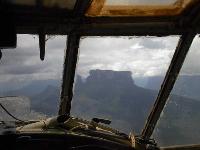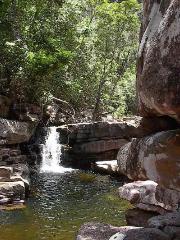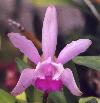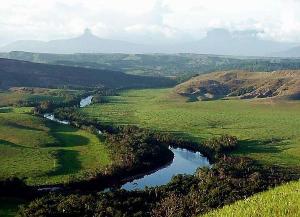…we were flying so near the walls of the Auyantepuis, below
was the green deep carpet of the jungle and suddenly there it
was, just between clouds and falling from the sky, Angel's Fall.
My mind was a chaos of delight. Fernando
Santos

of Venezuela
"The Lost World"
By Fernando Santos
Click images to enlarge
In April of 2003, Fernando Jr. and I travelled to one of Venezuela's most beautiful places, La Gran Sabana, also called "The Lost World". Our base was a village called Kamarata, where Capuchin monks run a mission. It was a great week with fantastic scenery, no bugs, no rain, full sun and many miles walked. It was the first time that Fernando Jr. had the opportunity to see this extraordinary place.
The region sits atop the Guyana Shield in the southeastern corner of Venezuela. Clouds blown from the eastern Africa coast and over the Atlantic Ocean shed their load as they meet the higher ground of the shield, feeding the huge watersheds of the Orinoco basin to the north and the Amazon to the south.
 The
geological background of the area is not well understood. There
are three main geological formations. The oldest is an underlying
igneous-metamorphic base formed some 1.2-3.6 billion years ago
while South America was joined to Africa as the super continent.
The first of these formations is too deeply buried within the
region, but second (known as the Roraima Group) forms the basis
of the area's extraordinary topography. It consists of quartz
and sandstone strata, which were probably laid down in shallow
seas. Lastly, during Palaeozoic and Mesozoic times magma repeatedly
penetrated the existing sediments forming intrusive rocks.
The
geological background of the area is not well understood. There
are three main geological formations. The oldest is an underlying
igneous-metamorphic base formed some 1.2-3.6 billion years ago
while South America was joined to Africa as the super continent.
The first of these formations is too deeply buried within the
region, but second (known as the Roraima Group) forms the basis
of the area's extraordinary topography. It consists of quartz
and sandstone strata, which were probably laid down in shallow
seas. Lastly, during Palaeozoic and Mesozoic times magma repeatedly
penetrated the existing sediments forming intrusive rocks.
The Gran Sabana is characterised by towering table-top mountains called tepuis with their vertical walls and waterfalls, plunged in infinite yellow-green savannahs and deep green jungle. The word tepuy is the Pemón (traditional inhabitants of La Gran Sabana) denomination of "Table Mountain" and is complex and profound. The tepuis are sacred mountains for the Pemón. They are the "guardians of the savannah" where the spirits (called Kanaima) in the form of men may steal the souls of the living.
The isolation and the height of the tepuis has allowed a very
special eco-system to develop and many species of plants and
animals are found there, species that have followed a different
evolutionary path than similar species that can be found just
a few miles away… botanists' paradise. We saw native Cattleya,
Laelia, Encyclia, Oncidium, Heliconia, Bromelia and a tiny
Sarracenia that I found on our way to a cave.
 |
 |
|
 |
 |
 |
 The
picture at the top of the page has a story. In the afternoon
after being at the village of Kavak, we went to see another small
Pemón village about two miles from Kavak. There was an
old four-wheel-drive Toyota pickup at Kavak that gave us a lift,
but something went wrong with the gearbox after crossing a river.
We walked to the village and then we went back, taking a short
cut to Kamarata, about eight miles walk. A huge storm was coming
from the southwest. After half an hour of the walk, I turned
and I saw the Auyantepuy... eight waterfalls were pouring down
from the lower terrace into the savanna. Due to the lack of light
they can't be seen in the picture.
The
picture at the top of the page has a story. In the afternoon
after being at the village of Kavak, we went to see another small
Pemón village about two miles from Kavak. There was an
old four-wheel-drive Toyota pickup at Kavak that gave us a lift,
but something went wrong with the gearbox after crossing a river.
We walked to the village and then we went back, taking a short
cut to Kamarata, about eight miles walk. A huge storm was coming
from the southwest. After half an hour of the walk, I turned
and I saw the Auyantepuy... eight waterfalls were pouring down
from the lower terrace into the savanna. Due to the lack of light
they can't be seen in the picture.
Profile - Fernando Santos